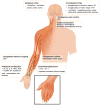Clinical features and pathophysiology of complex regional pain syndrome
- PMID: 21683929
- PMCID: PMC5511749
- DOI: 10.1016/S1474-4422(11)70106-5
Clinical features and pathophysiology of complex regional pain syndrome
Abstract
A complex regional pain syndrome (CRPS)--multiple system dysfunction, severe and often chronic pain, and disability--can be triggered by a minor injury, a fact that has fascinated scientists and perplexed clinicians for decades. However, substantial advances across several medical disciplines have recently improved our understanding of CRPS. Compelling evidence implicates biological pathways that underlie aberrant inflammation, vasomotor dysfunction, and maladaptive neuroplasticity in the clinical features of CRPS. Collectively, the evidence points to CRPS being a multifactorial disorder that is associated with an aberrant host response to tissue injury. Variation in susceptibility to perturbed regulation of any of the underlying biological pathways probably accounts for the clinical heterogeneity of CRPS.
Copyright © 2011 Elsevier Ltd. All rights reserved.
Conflict of interest statement
JM: none declared. GLM: none declared. FB: received fees as consultant and/or speaker from Pfizer, Grünenthal, Lilly, MedUpdate, Glaxo, and for expert testimony for Jerini. RB: received grants or research report from Pfizer, Genzyme, Grünenthal; is a member of the IMI “Europain” collaboration and industry members of this are: Astra Zenica, Pfizer, Esteve, UCB-Pharma, Sanofi Aventis, Grünenthal, Eli Lilly, Neuroscience technologies and Boehringer Ingelheim; received fees as consultant and/or speaker from Pfizer, Genzyme, Grünenthal, Mundipharma, Allergan, Sanofi Pasteur, Medtronic, Eisai, UCB BioSciences, Lilly, Boehringer Ingelheim, Astellas and Novartis. CM: received fees as consultant and/or speaker from Pfizer, Bionorica, Allergan and Grünenthal. WK: none declared. JJvH: received fees as consultant and speaker from Medtronic, GSK and Novartis.
Figures






References
-
- Albrecht PJ, Hines S, Eisenberg E, et al. Pathologic alterations of cutaneous innervation and vasculature in affected limbs from patients with complex regional pain syndrome. Pain. 2006;120:244–66. - PubMed
-
- van der Laan L, ter Laak HJ, Gabreels-Festen A, Gabreels F, Goris RJ. Complex regional pain syndrome type I (RSD): pathology of skeletal muscle and peripheral nerve. Neurology. 1998;51:20–5. - PubMed
-
- Oaklander AL, Rissmiller JG, Gelman LB, et al. Evidence of focal small-fiber axonal degeneration in complex regional pain syndrome-I (reflex sympathetic dystrophy) Pain. 2006;120:235–43. - PubMed
-
- Merskey H, Bogduk N. Descriptions of chronic pain syndromes and definitions of pain terms. 2. Seattle: IASP Press; 1994. Classification of chronic pain.
Publication types
MeSH terms
Grants and funding
LinkOut - more resources
Full Text Sources
Other Literature Sources
Medical

